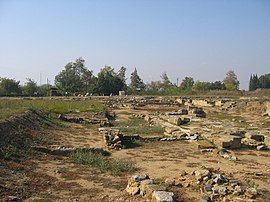Abdera
Άβδηρα | |
|---|---|
 Remains of the ancient city of Abdera. | |
| Coordinates: 40°56′N 24°58′E / 40.933°N 24.967°E | |
| Country | Greece |
| Geographic region | Thrace |
| Administrative region | Eastern Macedonia and Thrace |
| Regional unit | Xanthi |
| Government | |
| • Mayor | Georgios Tsitiridis[1] (since 2014) |
| Area | |
• Municipality | 352.0 km2 (135.9 sq mi) |
| • Municipal unit | 162.0 km2 (62.5 sq mi) |
| Elevation | 41 m (135 ft) |
| Population (2021)[2] | |
• Municipality | 17,610 |
| • Density | 50/km2 (130/sq mi) |
| • Municipal unit | 2,799 |
| • Municipal unit density | 17/km2 (45/sq mi) |
| • Community | 1,172 |
| Demonym(s) | Abderite, Abderian |
| Time zone | UTC+2 (EET) |
| • Summer (DST) | UTC+3 (EEST) |
| Vehicle registration | AH |
Abdera (Greek: Άβδηρα) is a municipality in the Xanthi regional unit of Thrace, Greece. In classical antiquity, it was a major Greek polis on the Thracian coast.
The ancient polis is to be distinguished from the municipality, which was named in its honor. The polis lay 17 km east-northeast of the mouth of the Nestos River, almost directly opposite the island of Thasos. It was a colony placed in previously unsettled Thracian territory, not then a part of Hellas, during the age of Greek colonization. The city that developed from it became of major importance in ancient Greece. After the 4th century AD it declined, contracted to its acropolis, and was abandoned, never to be reoccupied except by archaeologists.
During the Early Middle Ages, a new settlement emerged near the ancient city. It was called Polystylon (Greek: Πολύστυλον),[3] and later considered as the New Abdera (Greek: Νέα Άβδηρα). In 2011 the modern municipality of Abdera was synoecized from three previous municipalities comprising a number of modern settlements. The ancient site remains in it as a ruin. The municipality of Abdera has 17,610 inhabitants (2021). The seat of the municipality is the town Genisea.[4]
- ^ Municipality of Avdira, Municipal elections – October 2023, Ministry of Interior
- ^ "Αποτελέσματα Απογραφής Πληθυσμού - Κατοικιών 2021, Μόνιμος Πληθυσμός κατά οικισμό" [Results of the 2021 Population - Housing Census, Permanent population by settlement] (in Greek). Hellenic Statistical Authority. 29 March 2024.
- ^ Agelarakis & Agelarakis 2015, p. 11-56.
- ^ "Δ. Αβδήρων". EETAA. Retrieved 24 July 2022.

